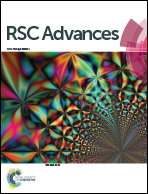Synthesis of tin oxide activated by DAN grafting and Mo nanoparticle insertion for optoelectronic properties improvement
Abstract
Tin oxide (SnO2) was synthesized via a co-precipitation method and activated by 1,5 diaminonaphthalene (DAN) grafting and molybdenum nanoparticles (Mo-NPs) incorporation. The resulting SnO2–DAN–Mo nanocomposites were characterized by X-ray diffraction, transmission electron microscopy, diffuse reflectance and FTIR spectrophotometry, photoluminescence spectroscopy and complex impedance spectroscopy measurements. The surface-grafting of DAN within mesopores was confirmed by Fourier-transform infrared spectroscopy. The XRD and TEM studies showed a dominant tetragonal structure. The dispersion of fine Mo-NPs on the surface of the matrices, produced slight structural compaction. The crystallite size decreased with the insertion of DAN and Mo-NPs. The photoluminescence study revealed the presence of oxygen vacancies and that the PL intensity strongly depends on DAN grafting and Mo-NPs insertion. In addition, both the incorporation of Mo-NPs and DAN grafting appear to be responsible for the changes in the conductance and relaxation phenomenon. The effects of surface groups of SnO2–DAN–Mo and charge transfer were found to be almost proportional to the capacitance. The above properties make these nanocomposites efficient electrode materials for green energy storage.


 Please wait while we load your content...
Please wait while we load your content...